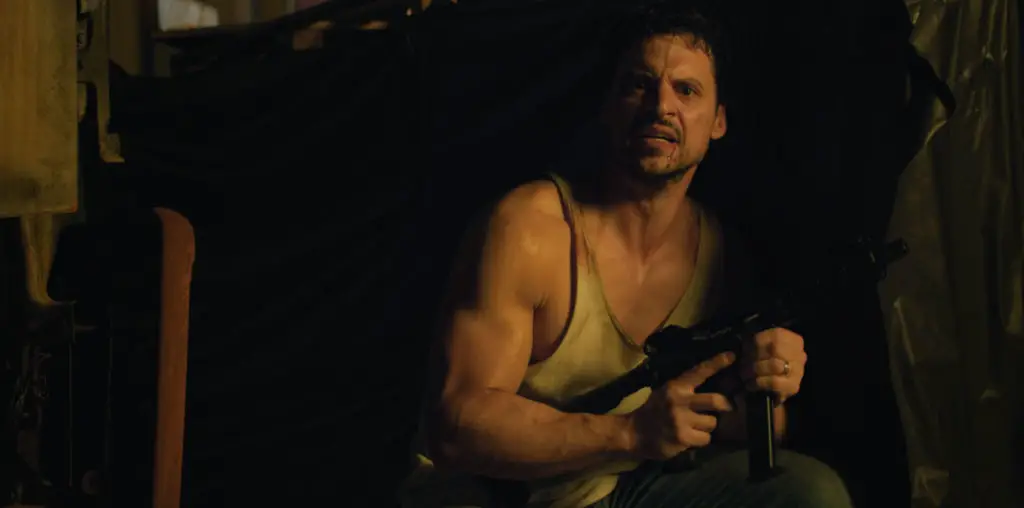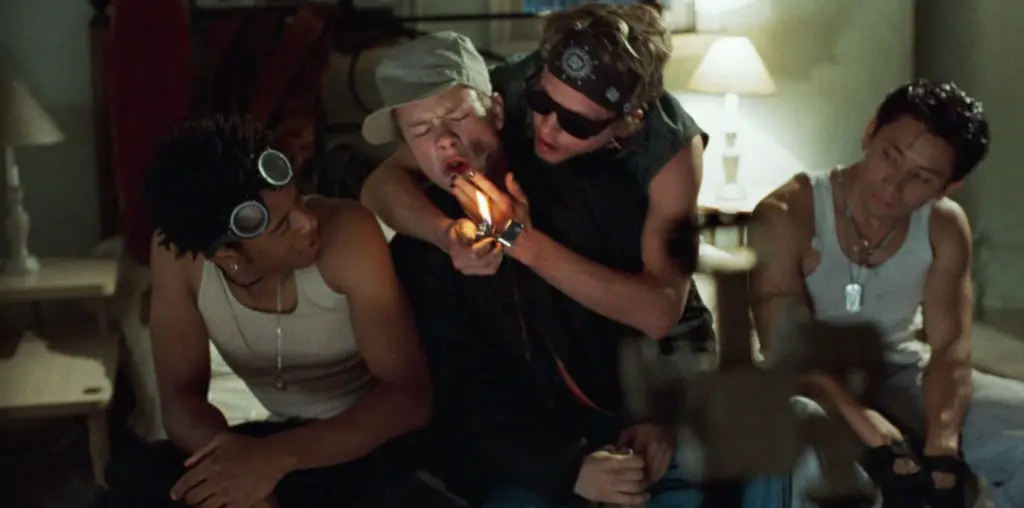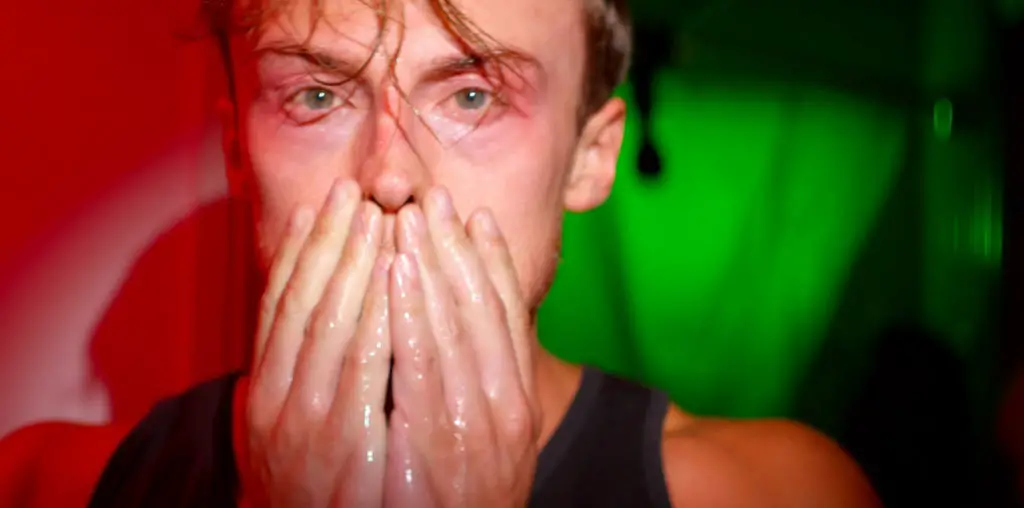
Mike Figgis is a soft-spoken but passionate man who, with his composer’s mane of untamed curly hair and wire-rimmed spectacles looks as if he might be an eccentric professor of dead languages.
His films have made him at times the darling of Hollywood, and at times has planted him firmly in the outskirts of Tinseltown. His latest work, “The Loss of Sexual Innocence,” is sure to cast him, for the time being, into the latter category.
Figgis doesn’t deliberately cultivate the role of cinematic pariah, but rather, in truest artistic fashion, simply makes the films he wants to make without regard to public or studio opinion. He has learned how to self-produce and direct features on his own take-it-or-leave it terms, and while not all audiences may be ready for what he wants to show them, Figgis’ approach is admirable purely because he is able to preserve his artistic aims. I had a chance to speak to him recently about his latest film, and asked him to reflect upon his career and technique.
[ One of my impressions when I saw this film is that I fear that this kind of movie is really subject to misinterpretation. I want to know if there have been any foolish questions or observations made about this movie. ]
No, but what often happens in this situation is that you get aggressive questions which are kind of deliberately stupid or deliberately kind of obvious. And you realize that the subtext is provocative. At Sundance when we did the Q & A after the first screening of this, the first question was, “Can you tell me what this film was about?” The subtext was fairly aggressive, so I said “No, because if you don’t get it having watched it for two hours, there’s absolutely now way verbally that I think I’m going to be able to explain it to you because it’s actually written as a film, not as an intellectual kind of treatise,” or something like that. I actually think it’s not that open to misinterpretation. Adam and Eve is Adam and Eve. You know that story. And I think on a one-to-one basis each of the stories is fairly obvious, what the stories are about.
What is personally open to interpretation, and is entirely valid, is the response to the sum total of the stories. And the reason why that’s open for grabs is that that is the point of any film, is how it touches the subconscious of an individual viewer; it’s entirely up to that person, you know? But on a kind of one-to-one basis, it’s pretty black and white, I think.
[ You’ve talked about it growing out of your experiences in multimedia and performance. So does this really represent a return to your roots in a way? ]
Yes, it does. Because to that period, which covers the period of my life from 21 to 37, something like that, where I was constantly working in theatre and constantly touring, was the most hard-working period of my life intellectually, where the whole quality of the work was at such a high level, and was a high quality of cooperation, four or five people, and creativity.
As much as I adore filmmaking, and the mainstream filmmaking process is fascinating, so much of the time is absorbed by technical conversations, and about fascination with the technique of filmmaking, and not with the core, the intellectual sort of reason for why you’re making the film, or what the point of the film is, or challenging the genre of the storytelling mode, and so on. But going back to a less-structured linear approach, it’s like a breath of fresh air in a way, because I guess I’m more comfortable in that mode. It’s tougher, and therefore I feel like I’m using my faculties in a way that I haven’t really aired for a while.
[ So how does that background influence your æsthetic style in the film? ]
It teaches your to use your eye, and to be aware of, if you like, a sort of Zen quality, which is the ability to stand very, very still, and then discover what’s moving, rather than letting off a bomb and watching things fly away from the noise, which is often the film approach. Create absolute stillness, and then you can judge what is genuinely moving or not. Or as Donald McCallum, the watercolor artist, said someone said to him, “Why do you paint your pictures so dark,” and he said, “If I didn’t do that, how would you know where the light was in the picture?” And it’s a very profound thing, and I’ve stolen that quote so many times. I’ve never heard another quote that so sums it up for me.
[ How did you get Benoît Delhomme involved in the project? I think he’s one of the most brilliant cinematographers on the planet. And how did his style affect your work, and how did you essentially collaborate on getting the final look of the film? ]
The first really interesting collaboration I had with a cinematographer was with Declan Quinn on “Leaving Las Vegas.” Declan is a beautiful man, lovely cinematographer. There are two very interesting articles in American Cinematographer, one by Declan and one by Benoît, both about our experiences together. Declan was the first person that didn’t mind me operating with him, so we ran two cameras side by side, and kind of choreographed our moves together, and things like that. And he didn’t have a problem with that. Then after “One Night Stand,” which was 35 mil, and bigger, and grew lumpier in a way, we had, not a falling out, but — it wasn’t an entirely happy marriage, the crew and myself. So when I was making this film, and the film after “Miss Julie,” which I just finished, I started looking for another cinematographer.
I suddenly was in pre-production, basically, and I was now looking at different cinematographers, and you get very insecure, because it’s such an important thing, and I’ve got to have a good relationship with this guy, and suddenly one of the agents rung me up and said this guy Benoît Delhomme. I’d rung them, I said “Is anybody else available?” and they told me a Swedish cinematographer, and they told me Benoît. And I said, “Listen, you always do this to me, I’m going to look at these tapes. Are both these guys actually available? Because if I fall in love with them and you tell me he’s doing a movie, I’m going to be angry.” So they checked, and they said, “Well, actually, no, the Swedish one is actually doing a film.” I said, “Great, thanks, I’ll throw that tape away; I’m not going to look at that.” So I was left with “Cyclo,” which I hadn’t seen. And they said, “Oh, by the way, Benoît has actually bought a ticket at his own expense, and he wants to meet you, and he’s coming over on Monday.” And I went, “Oh, great. I hope I like his work.” So I went home and I put the tape on, and I think within ten minutes I was going, “Jesus Christ.”
He turned up on a Monday, we went and had a very bad meal in London, I’d discovered I’d left all my money and had no credit cards, and he had to suddenly pay for the meal as well as the ticket. I felt so embarrassed, I said, as he was getting his money back, I said, “Can I offer you the film at least?” And he said, “Well, yes,” you know, very low-key and everything. And so that’s how we got involved, and we’ve now done our second feature together. He’s phenomenal.
[ “Cyclo” blew my mind. ]
Mine, too.
[ In the first ten minutes my jaw dropped. And I had already seen “Scent of Green Papaya.” And “Cyclo” was just like a slap in the face. How did you decide to shoot in 16mm? I know you’ve done it before, specifically with “Leaving Las Vegas,” but how does that tie into your æsthetic of shooting the film and how it looks onscreen? ]
Well, it’s a bit like sort of deconstructing. I’ve got ProTools in my studio to do the sound. I’ve also got a 25-year-old Ampex reel-to-reel, and sometimes I bounce off analog for the soundtrack before I go back into digital just to kind of almost remind myself that we’re not recreating reality, we are painting a picture, and we are approximating reality. I like digital and I like the analog feel. And I would say super-16 is almost the analog that compares with almost the digital that 35mm has become. 35 seems to get cleaner and clearer and sharper and more colorful in a certain way, and ends up looking like s**t by the time its been through the projector 50 times as well. And if you balance with that the idea that the Aaton camera is something literally you can run with two inches off the ground, and then pull up — you can do things on that camera that you actually cannot do on 35. And film stocks are now so good, that the blow-up from 16 to 35 is not discernibly different from 35 to 35 second generation, which is what happens anyway. Plus in that process you push the contrast a tad, because that’s what happens in second generation, and I like that.
[ Plus you get that grain, I imagine as well, which is very attractive. ]
You know you have to work really hard to get grain. You’ve got to use the fast stock and you’ve got to push it. And it’s tough to get that feel. I mean a lot of the look in this film is shooting on Ektachrome and cross-processing to create the negative. And if you do that in the camera, you have no control over what happens to the color, and at a certain point I thought there’s something so exciting about not knowing what’s going to happen to the color. But it puts an edge on this that you wouldn’t normally get, so that’s serious.
[ Has the fact that “Leaving Las Vegas” has been so successful given you the leverage to do the films you really want to make? ]
Mm-hmh.
[ In what way? ]
In the obvious ways. I mean, the film made money. And that’s the bottom line.
[ The bottom line in Hollywood. ]
The bottom line in the world. And it comes to financiers who actually do it, you know, say, “I’ll give you 500,000 dollars,” or whatever it is. They look at box office returns, they don’t really read scripts. But at a certain point if a film like “Leaving Las Vegas” which everybody passed on, which cost three million dollars, can become the third most successful film in that year — in terms of the ratio of budget to profit, it was the third most successful film in the world that year — then you basically take those figures along and say, “I want to make another film for about three million dollars,” it’s a lot easier. Plus, I went the sort of Wim Wenders route on this one, which is I own the negative, and I pre-sold individual European territories via a sales agent in order to raise the money, that’s a guarantee against a bank loan, so I produced the film. It’s a good way, I did it with the studio, too.
[ And you maintained that control every step of the way. ]
If you’re selling on a territory-to-territory basis no one has the right to anything other than to acquire the film when it’s finally printed. They have no say in the music or in the final casting. You get complete autonomy, which I take for granted in these circumstances. But one shouldn’t, because it is so unusual for a filmmaker to have that much control, and then be able to actually be sitting here on the 13th and talking about the release of the film, you know?
[ How does composing your own soundtrack affect your final film? The rhythm and the pacing — does it have something to do with that? ]
Well, they’re all in bed together equally. You make the film with the luxurious knowledge that you will have control of the music in the future, rather than somebody comes in and starts to compete with your rhythms in a way that is not sensible. It’s as simple as that. If you’re making a slow, rhythmic film, with long waves rather than short choppy ones, you’ve got to be damn sure that the musician is aware of that. If you’re doing certain things as I do — a four-minute creeping zoom — I know as I’m doing that that this is a joy for the composer because you do “creeping zoom” music, basically. Music that insinuates itself so slowly into the soundtrack. And all those are noted in every stage of the process.
Your job as a seasoned and mature filmmaker is you measure that by the director’s capacity to hold all those bits of information in his head, and finally, as a conductor would, put them all together in the correct order. Unscramble the information And I’m always stunned by the fact that there are some brilliant directors that who do that except for the music, at which point they invite somebody in to basically destroy everything that they’ve done, in my opinion.
[ What has working with Hollywood taught you, and in what directions has it pushed you as an artist? ]
It’s great — it’s like going to business school. What it is, is a very highly concentrated, highly evolved practical education in the economics and structure of the studio system; where the real power is, and where the money’s wasted, and why it costs so much. How you can never win a battle, you can merely go with the flow and influence the direction of the flow, but you can never control it.
It’s like basically going into the computer industry as an executive, and getting fired, and coming back and then deciding to form your own company based on the fact that you now understand the market. Invaluable, absolutely invaluable. I don’t believe you can make a low-budget independent film unless you understand what it is you’re competing with.
[ Where do you think you’re going as an artist? What’s your evolution as an artist? ]
I think the best thing you can hope for is to get into some kind of a forward energy. I can’t envisage never having an idea. I can envisage fatigue with the concept of big filmmaking. I’ve become more and more intrigued with the concept of documentaries. I’ve done three and I’m editing a fourth. Because, technically speaking, the advent of the small DV camera — which also it has the potential of recording really good sound, so all you need to do is buy a decent microphone — you can basically go out and make a very good film by yourself with one camera, which is a phenomenal idea, because the psychology of that is that you take away the film crew, and you have an intimacy which you can never have. And as a film director you spend most of the time trying to recreate realistic intimacy in a situation that couldn’t be further from intimacy. Basically in a one-on-one situation, or a one-on-two, the dynamic is so different.
In answer to your earlier question, one of the great things about 16 millimeter is that actors who have gone out into the 35mm world, when they see 16mm, they think it’s lesser. Their inner self informs then that this is not a big film, and their performance increases, it gets better, because the bullshit factor disappears. And a humility appears in their acting, because they don’t really think it’s so serious.
[ In there a main theme that runs though your work that you’ve noticed? ]
Yeah, I mean a sort of preoccupation with the unpredictability of, say, death, and of your life. And the way events can kind or arbitrarily alter it at any given moment, which I think is fairly accurate. So I’m interested in reality, I suppose, and I’m not really interested in fantasy. I’m not interested in any picture of the world which I think is not true. Or telling lies to people in order to sort of cosmetically, temporarily brighten up their lives.
I think flamenco philosophy is correct; life should be a celebration of and an acceptance of the inevitability of your own death. Therefore you know there’s a framework, there’s a start and an end. You don’t know quite how long the middle of it is, but you’d better damn well celebrate it, in some way.
Check out FILMTHREAT.com’s INTERVIEW ARCHIVES and read hundreds of fascinating in-depth interviews with directors, filmmakers, actors and celebrities from the world of film!


